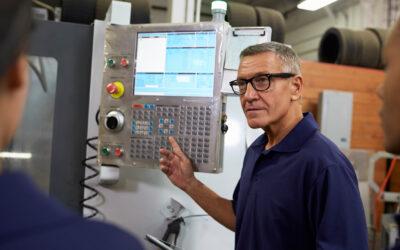The onset of the COVID-19 pandemic resulted in widespread uncertainty and disrupted many of the conditions that manufacturers had taken for granted. But now, nearly three years later, it’s clear that the pandemic simply accelerated the trends and challenges that were already changing the way that manufacturers approached technology.
In today’s volatile market, manufacturers must begin to shift away from short-term efficiency gains and view investments in automation technology through the lens of long-term resiliency. By taking a strategic approach that places flexibility, agility, and adaptability ahead of cost-savings, manufacturers will be better able to withstand future disruptions and remain competitive even as new challenges emerge.
The challenges facing manufacturers
Manufacturers are navigating a fast-changing and increasingly uncertain environment. A 2022 Deloitte report found that 90 percent of executives agreed that the frequency of disruptions has increased over the past decade. These challenges are wide-ranging and have multiple causes, making it difficult and impractical for manufacturers to respond to each of them individually.
Among these challenges, 81 percent of executives cite labour shortages, while 86 percent cite inflationary pressures and rising costs. Additionally, supply chains continue to struggle to adapt to the new landscape, with 80 percent of executives experiencing a heavy or very heavy impact on their supply chain. In Canada, a recent Statistics Canada report showed that the total number of manufacturers facing raw materials shortages nearly tripled in 2022 compared to the same period in 2019.
The trade-off between efficiency and resiliency
Investments in new processes and technologies have typically been focused on improving efficiency metrics such as cost, throughput, speed, and labour. While these benefits are important, veering too far in the direction of efficiency can limit an organization’s ability to respond to change.
Efficiency, by its nature, is short-term oriented. It emphasizes the capture of the maximum value within an existing environment.
Resiliency, on the other hand, requires long-term thinking. It requires redundancy, which is inherently inefficient, and emphasizes the ability to adapt to new conditions.
There is always a trade-off, and manufacturers must determine what they will focus on when considering new technologies. But there are promising signs. A 2022 PwC global study reported a 67 percent increase in the number of companies saying that resiliency and flexibility are key drivers of investment.
5 ways manufacturers can enhance resiliency through automation technology
Manufacturers can respond to uncertainty in various ways. For some, the solution is simple – grind harder, work more, and optimize existing processes. However, this approach is not sustainable and does nothing to address the underlying challenges over the long term.
Instead, manufacturers can approach the problem strategically and critically evaluate their current way of doing things to find new solutions.
1) Be proactive, not reactive
It’s far easier to respond to challenges when steps have been taken to be prepared. Being reactive, on the other hand, risks being unfocused. It does not allow time for careful problem-solving, and, faced with multiple challenges, manufacturers can quickly become overwhelmed as they scramble from one problem to the next.
A recent RBC report showed that the companies that had best survived the recent economic downturn were those that had already invested in digital transformation and the upskilling of their employees. While other companies were flailing, they were able to pivot faster and respond more quickly to changing conditions.
2) Establish strong principles
In times of uncertainty, manufacturers need to make difficult decisions and see them through. To do this effectively, they need to establish strong principles that align with the organization’s values and purpose. These act as the guiding lights that shine through when the finish line is difficult to see, and they keep everyone working together and aligned when making strategic decisions.
3) Develop an Automation Strategy
A recent survey found that 22 percent of organizations do not have a clear and accepted vision for intelligent automation, while 41 percent do not have an enterprise-wide automation strategy.
The Automation Strategy is based on the strategic goals of the business, the manufacturing strategy, and the guiding principles of the organization. It allows manufacturers to take a holistic view of technology and see how new solutions fit into the existing and future production environment. It provides a unified design philosophy, a structure for decision-making, and a framework for choosing the right technologies.
4) Invest in the right solutions
Technology, on its own, does not automatically make an enterprise more resilient. The chosen solutions must fit into the Automation Strategy and move the manufacturer closer to its strategic goals.
With so many technologies, hardware, software, machines, and equipment available on the market, it can be difficult to know where to start. An Automation Strategist can help by bringing a wealth of experience in manufacturing strategy, automation, and technology. By working closely with the internal teams, the Automation Strategist can identify new opportunities, understand the latest solutions, and guide strategic decision-making.
5) Build long-term strategic relationships
Manufacturers do not have to take on these challenges alone. A strategic partner brings additional skills, experience, and capabilities that augment internal automation teams while providing expertise in automation strategy and technology.
A recent survey found that 60 percent of manufacturing executives are partnering with specialized technology companies to further their initiatives. By leveraging the strengths of a partner, manufacturers can implement new processes and technologies that allow for flexibility and adaptability in the future.
Making things: resilient with automation technology
Automation technology offers significant opportunities to lower costs, enhance productivity, and deliver higher-quality products to customers. But in a highly uncertain and volatile market, manufacturers must also place a renewed emphasis on resiliency, flexibility, and adaptability. By taking a holistic approach to technology, establishing guiding principles, developing an Automation Strategy, choosing the right solutions, and partnering with a trusted expert, manufacturers can proactively respond to challenges and position themselves for long-term profitability and success.



